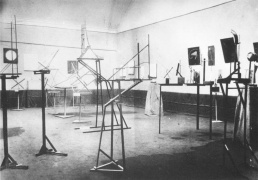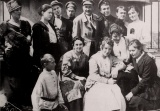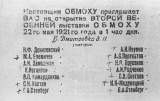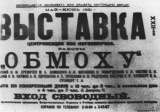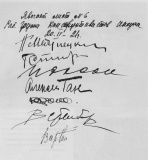OBMOKhU
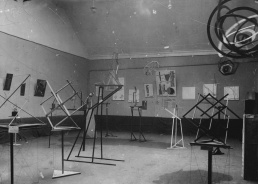
The Society of Young Artists [ОБМОХУ; Общество Молодых Художников; Obschestvo Molodykh Khudozhnikov] was a group of Soviet artists who experimented with spatial constructions and the properties of industrial materials; active between 1919-22.
Contents
Formation
OBMOKhU was founded by GSKhM (ГСХМ; the State Free Art Workshops) students in Moscow in the autumn of 1919. Originally, it was called OBMOLDUKh.
The society has at first included the students of B.Grigoriev's workshop, who had organized in September 1919 the so called "leaderless workshop". Its frequenters were G.Alexandrov, N.Glushkov, L.Zharova, P.Zhukov, K.Kozlova, N.Menshutin, A.Naumov, N.Prusakov, S.Svetlov and others. They were joined by students of G.Yakulov's theatre-decor workshop: N.Denissovsly, S.Kostin, K.Medunetsky, Stenberg brothers; as well as A.Lentulov's painting workshop: V.Komardenkov, A.Zamoshkin, A.Perekatov and others.
OBMOKhU operated at the IZO department of NARKOMPROS. In its first year the society existed mainly as the "industrial artists" artel, fulfilling the artistic needs of the new community life, the new regime. Orders came primarily from NARKOMPROS departments and commissions, and consisted mainly of posters and the decorative design for all kinds of agit and propaganda material for the new Soviet government. Many orders were received from the All-Russian Special Commission for the Elimination of Illiteracy. The "artistic products" were signed by the collective signature "OBMOKhU", and the payment was divided evenly between all members creating them.
Exhibitions and formation of Constructivist Working Group
During its period of existence, two OBMOKhU exhibitions were held (although in some sources four are mentioned, with the first being anonymous, collective, held in 1919). The first exhibition has taken place in May 1920 at the society at its base, formerly Faberge shop at Kuznetzky Bridge. 13 students participated. The works were not socially useful designs, but open spatial constructions making dynamic use of the spiral form. The second exhibition opened on 22 May 1921, in what has been Mikhailova Salon. It appears, although not confirmed, that OBMOKhU has also taken part in the exhibition timed at the Third Congress of the Comitern, at the Continental Hotel in June 1921.
The event that brought fame to the society is the second exhibition (in some literature this exhibition is called the third). OBMOKhU was represented by Alexander Rodchenko, Karl Ioganson, Konstantin Medunetsky and Stenberg brothers. Their works took up an entire hall. The sculptures displayed a strong commitment to the materials and forms of contemporary technology. The Stenbergs created skeletal forms from materials such as glass, metal and wood, evoking engineering structures such as bridges and cranes, as in Georgy Stenberg's Spatial Construction/KPS 51 NXI. Rodchenko showed a series of hanging constructions based on mathematical forms; they consisted of concentric shapes cut from a single plane of plywood, rotated to create a three-dimensional geometric form that is completely permeated by space, for example Oval Hanging Construction. In 2006, the works were reconstructed from photographs and exhibited in Tretyakov Gallery [1]. In the context of contemporary artistic life of those months, this exhibition served to establish new forms, brought forth by the First Working Group of Constructivists at INKhUK which had formed by March 1921: Rodchenko, Ioganson, Medunetsky, Stenberg brothers, Aleksei Gan, Stepanova (their first organisational meeting was held 23 February, the first official one 18 March [2]).
Color constructions, spatial construction, spatial sculptures and other works presented were the product of experimental Constructivism, creative and practical developments made by this first group. In the eyes of their fellow artists, as well as later generations, the name of OBMOKhU was irreversibly bonded to the early stage of Constructivism; the discussions held in INKhUK in 1921 have also labeled OBMOKhU firmly as "Constructivism Society".
Dispersal
The society has dispersed in early 1922, some participants continued to work under different banners: as "Constructivists", in 1922, with K.Medunetzky and the Stenberg brothers; as "The First Working Artists Organization", from 1924 onwards, with G.Alexandrov, P.Zhukov, I.Korolev, K.Loginov, N.Menshutin, A.Rudnev, M.Sapegin, A.Stepanov, I.Yakovlev; and in 1925 N.Denisovsky and S.Kostin joined the OST group. The Constructivists signed a manifesto condemning non-useful (i.e. 'fine') art as a 'speculative activity', and thereafter devoted themselves to theatrical or industrial design. (based on the source)
Literature
- Ulen (El Lissitzky), "Die Ausstellungen in Russland", Veshch/Gegenstand/Objet 1-2, Berlin: Skythen, Mar-Apr 1922, pp 18-19. (German)
- Aleksandra Shatskikh, "A Brief History of Obmokhu", in The Great Utopia: The Russian and Soviet Avant-Garde, 1915-1932, New York: Solomon R. Guggenheim Museum, 1992, pp 257-265. (English)
- Maria Gough, "In the Laboratory of Constructivism. Karl Ioganson's Cold Structures", October 84 (Spring 1998), pp 90-117; new version as "In the Laboratory of Constructivism", ch. 2 in Gough, The Artist as Producer: Russian Constructivism in Revolution, University of California Press, 2005, pp 60-99. (English)
See also
Links
| Art exhibitions and events | ||
|---|---|---|
|
Second Spring Exhibition of OBMOKhU (Moscow, 1920-21), Congress of International Progressive Artists (Düsseldorf, 1922), Congress of the Constructivists and Dadaists (Weimar, 1922), First Russian Art Exhibition (Berlin, 1922), New Art Exhibition (Vilnius, 1923), Zenit Exhibition (Belgrade, 1924), Contimporanul Exhibition (Bucharest, 1924), Machine-Age Exposition (New York, 1927), a.r. International Collection of Modern Art (Łódź, 1931), New Tendencies (Zagreb, 1961-73), The Responsive Eye (New York, 1965), 9 Evenings: Theatre and Engineering (New York, 1966), Cybernetic Serendipity (London, 1968), Live In Your Head: When Attitudes Become Form (Bern, 1969), Information (New York, 1970), Software - Information Technology: Its New Meaning for Art (New York, 1970), Documenta 5 (Kassel, 1972), Pictures (New York, 1977), Biennial of Dissent (Venice, 1977), Les Immatériaux (Paris, 1985), Magiciens de la Terre (Paris, 1989), Hybrid Workspace (Kassel, 1997) | ||
